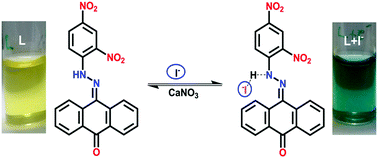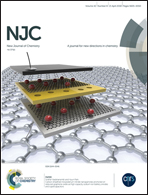Highly selective iodide sensing ability of an anthraquinone-derived Schiff base in semi-aqueous medium and its performance in antioxidation, anti-inflammation and HRBC membrane protection†
Abstract
In this study, a new iodide (I−) ion selective chromogenic receptor (3) was developed by reacting 9,10-anthraquinone with 2,4-dinitrophenylhydrazine. The sensing ability of the receptor 3 was studied with different anions such as F−, Cl−, Br−, I−, HSO4− and H2PO4− through naked-eye detection and UV-Vis spectroscopy in pure THF and mixed THF : H2O (1 : 1, v/v) media. In semi-aqueous medium, the receptor 3 showed a strong absorption band at 420 nm due to the presence of donor and acceptor units that resulted in an intense ligand-to-ligand charge-transfer (LLCT). Upon the interaction with I−, the receptor 3 showed a selective colour change from yellow to dark blue along with the formation of a new UV-Vis band at 615 nm. The absorption spectral studies indicate the formation of a complex between the receptor 3 and the I− ion with an estimated association constant of 1.37 × 104 M−1. The binding interaction of the receptor 3 with I− was examined by using 1H NMR, FTIR and density functional theory (DFT) calculations. The receptor 3 can detect I− at the concentration as low as 2.7 μM without any interference from other tested anions. Additionally, the pharmacological significance of the receptor 3 was explored. The receptor exhibited COX-2 inhibition of 70.18%, antioxidant activity of 73.42% and HRBC membrane protection ability of 67%.



 Please wait while we load your content...
Please wait while we load your content...